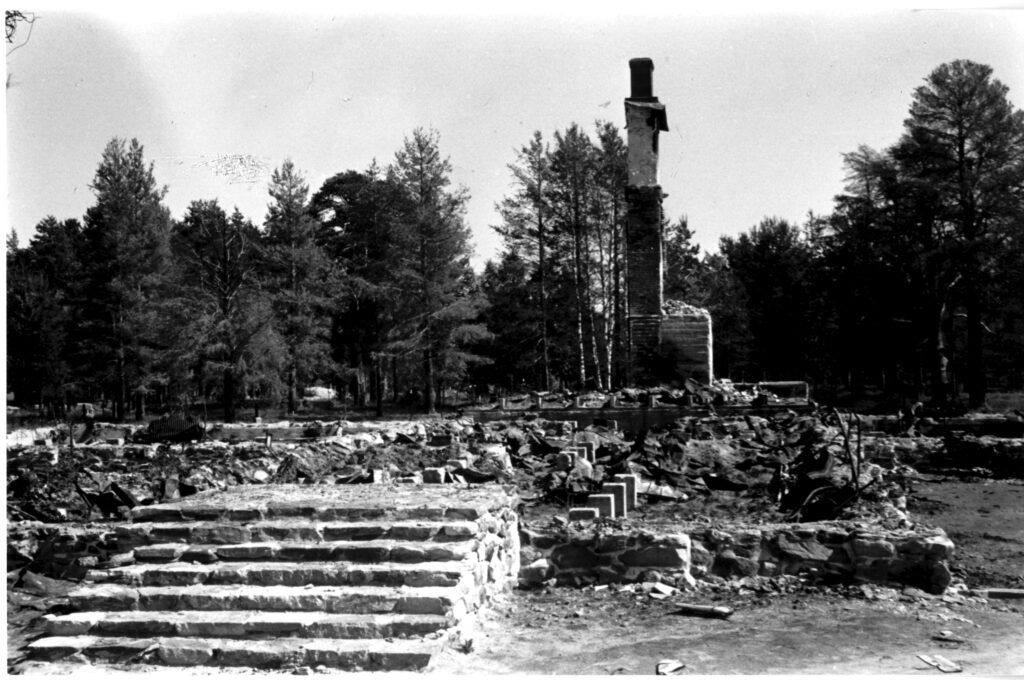When the other villagers moved to the evacuation centres in the fall of 1944, vicar Poukkula, cantor Marttinen and clockmaker Tammi remained with a few other villagers to save the church’s most valuable objects. The altarpiece, the wall sconces and the chandelier were saved, but the bells were too heavy (a total of one thousand kilos) to be taken down from the belltower. They tried to lower the bells with the ropes found in the Osuuskauppa, but to no avail. It was feared that dropping them would break them.
The Kuusamo church bells mysteriously disappeared at the end of the war in 1944. Even then, it was not certain whether Finns, Germans, Russians, or others were behind the disappearance of the bells. The church town of Kuusamo was first under the control of the Germans and then the Russians, and after the Kuusamo people returned to their homeland, the church in the town was burned down. One assumption was that the Germans would have sunk the sunk in Lake Kuusamojärvi or taken them with them when they retreated and sunk them in the sea later.
In 1945, inquiries were made to the Soviet Union about the fate of the bells, but according to the answer received there, the soldiers stationed in Kuusamo had no information about them. Vicar Eerola said that in 1949 he had a dream in which German officers appeared to him and said: “You shouldn’t worry, because the bells can be found. They are in the well of the vicarage.” Based on this, some private individuals explored the well of the old vicarage, but without results.
Quote from Schreiber’s memoir (Finnish translation by Sampo Ahto [KST 427 – 430] ):
- “We knew that there were very old and valuable bells from the year 1611 in the belltower of the Kuusamo church, which were not allowed to fall into the hands of the Russians. The pioneers of our division were given the task of removing the bells from their place and taking them to safety… So, both bells were dug into the cemetery next to the church and disguised as a grave.” According to Franz Schreiber’s memoirs, the church was left standing after the remnants of the SS mountain jaeger regiment left Kuusamo:
The fact that the opponent came after us to Kuusamo and stayed there for several weeks did not come to our attention. We also didn’t know that the Russians destroyed not only the cemetery, but also the church and the belltower that stood next to it. The Finnish civilian population, which was allowed to return only in May 1945, found only ruins in the church town.” Source Lapin sota.
When the new church was completed in 1951, the congregation of Umeå donated a bell to Kuusamo, and the congregation itself bought another with gift funds received from Sweden. It was hoped that the new bells would sound as beautiful as the old ones, but their sound turned out to be much weaker. The sound of the old bells was said to have carried all the way to Nissinvaaraa. Even in good weather, the new bells couldn’t carry the sound even to Nilonkangas.
Kuusamo was not aware that in 1944, the commander of the Finnish forces operating in White Sea Karelia during the war, Colonel V. Paloheimo, had asked the head of the German burning squad that the church bells be taken down and hidden. This request was carried out by the German Mountain Jaeger Regiment 12, commanded by Colonel Franz Scheiber. When the Germans had to withdraw from Finland and join the battle on the Western Front, many of them fell, taking the exact location of the bells with them to the grave.
